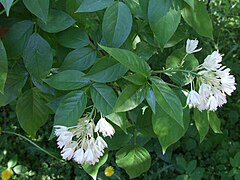Staphylea trifolia
| Staphylea trifolia subsp. var. | Bladdernut, Eastern bladdernut | |||||||||||||||||||||||||||||||||||||||||||||||||||||||
|---|---|---|---|---|---|---|---|---|---|---|---|---|---|---|---|---|---|---|---|---|---|---|---|---|---|---|---|---|---|---|---|---|---|---|---|---|---|---|---|---|---|---|---|---|---|---|---|---|---|---|---|---|---|---|---|---|

|
|
| ||||||||||||||||||||||||||||||||||||||||||||||||||||||
| ||||||||||||||||||||||||||||||||||||||||||||||||||||||||
Staphylea trifolia (American Bladdernut) is native to eastern North America, from southern Ontario and southwestern Quebec west to Nebraska and Arkansas, and south to Florida.
It is a medium sized shrub growing to 11 m tall. The leaves are opposite, compound with three leaflets, each leaflet up to 10 cm long and 5 cm broad, with a serrated margin. In spring, they produce pendant white flowers, followed by the bladder-like, teardrop-shaped fruits that contain several large black seeds.
| Standard Cyclopedia of Horticulture |
|---|
|
Staphylea trifolia, Linn. American Bladder-nut. Upright shrub, with rather stout branches, 6-15 ft. high: lfts. oval to ovate, acuminate, finely and sharply serrate, slightly pubescent beneath or almost glabrous, 1 1/2-3 in. long: fls. about 1/3 in. long, in nodding panicles or umbel-like racemes; sepals greenish white, petals white: caps. much inflated, usually 3-lobed, l 1/3 - 2 in. long. April, May. Que. to Ont. and Minn., south to S. C. and Mo. Var. pauciflora, Zabel. Low and suckering: lfts. smaller, broader, glabrous at length: fls. in short, 3-8-fld. racemes: fr. often 2-lobed, 1 1/3 – 1 1/2 in. long. CH
|
Cultivation
Propagation
Pests and diseases
Varieties
Gallery
References
External links
- w:Staphylea trifolia. Some of the material on this page may be from Wikipedia, under the Creative Commons license.
- Staphylea trifolia QR Code (Size 50, 100, 200, 500)
